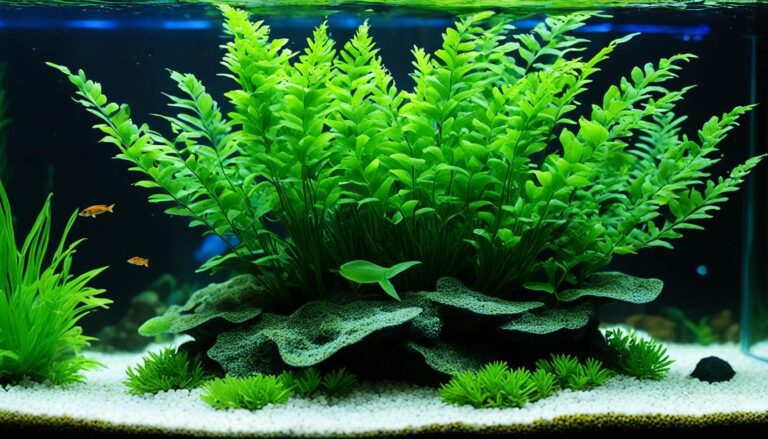Welcome to the world of Java fern care, where both newbies and seasoned aquarium enthusiasts can find real joy. The Java Fern, scientifically known as Microsorum pteropus, is a fantastic addition to any aquatic setup. It’s adored for being low-maintenance and incredibly adaptable.
Hailing from the warm waters of Southeast Asia, this plant adds a touch of elegance with its lush, deep green leaves. Java ferns can grow up to 12 inches tall, so you’ll want a tank that’s at least 10 gallons. Though they grow slowly, their beauty makes the wait totally worth it.
Lighting plays a big role in how fast your Java fern will grow. They thrive under light levels between 5000 to 7000 K. Luckily, most aquarium lights meet these needs, keeping your plants both happy and healthy.
Not only do Java ferns look great, but they also help clean the water as they grow. Their unique method of propagation is pretty cool too—one leaf can give rise to up to 20 new plants! Watching them gradually fill your tank with life is truly amazing.
Java ferns prefer water with a pH between 6 and 7.5. They’re tough plants, able to handle various water conditions, and they get along well with many types of tropical fish, making them excellent tank mates.
There are different varieties of Java Fern, like Narrow Leaf and Needle Leaf, each bringing its own unique charm to your aquarium. And the best part? Fish usually leave them alone, so you don’t have to worry about them getting nibbled.
Sometimes, Java ferns might have to compete with algae, but a good water flow will help them come out on top. You can easily find these plants at pet stores, online, or even from fellow aquarium enthusiasts.
The Wide World of Java Fern Varieties
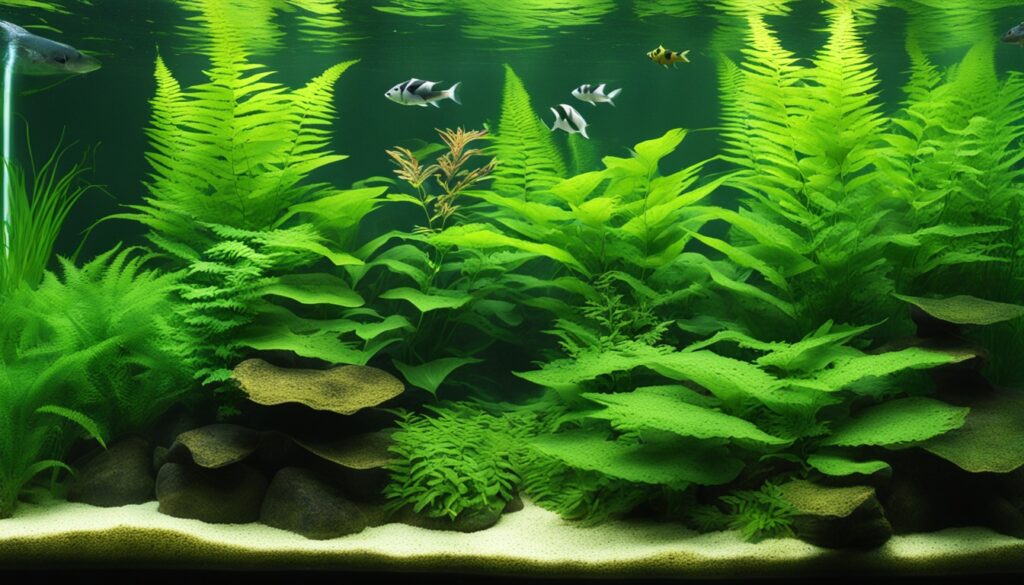
If you like aquascaping, diving into Java fern varieties can spice up your tank. The Microsorum pteropus, or Java Fern, has types like Needle Leaf, Narrow Leaf, ‘Windelov’, and Trident. Each has its own look and benefits but all are easy to care for.
The ‘Windelov’ Java Fern has unique, forked leaves. It’s named after the Tropica Aquarium Plants founder. It’s tough and simple to grow. These plants are perfect for any level of experience. They do well in different light and don’t need soil.
Java fern varieties easily adjust to new tanks in about 1-2 months. Below is a table showing what each brings to the table:
Variety |
Height |
Leaf Size |
Visual Appeal |
|---|---|---|---|
Standard Microsorum pteropus |
Up to 12 inches |
3-5 inches wide |
Classic broad leaves |
Needle Leaf |
Up to 10 inches |
Long, slender leaves |
Fine-textured look |
Narrow Leaf |
Over 12 inches |
Half as wide as standard |
Elegant, streamlined foliage |
‘Windelov’ |
8-10 inches |
15-25 leaves per rhizome, intricately forked |
Highly decorative, complex edges |
Trident |
Up to 15 inches |
Three-lobed leaf style |
Multi-dimensional texture |
Picking a Java fern variety like ‘Windelov’ can make your tank look deeper. These plants are great with peaceful fish. They help create a beautiful and balanced underwater world.
Introducing the Java Fern to Your Aquarium
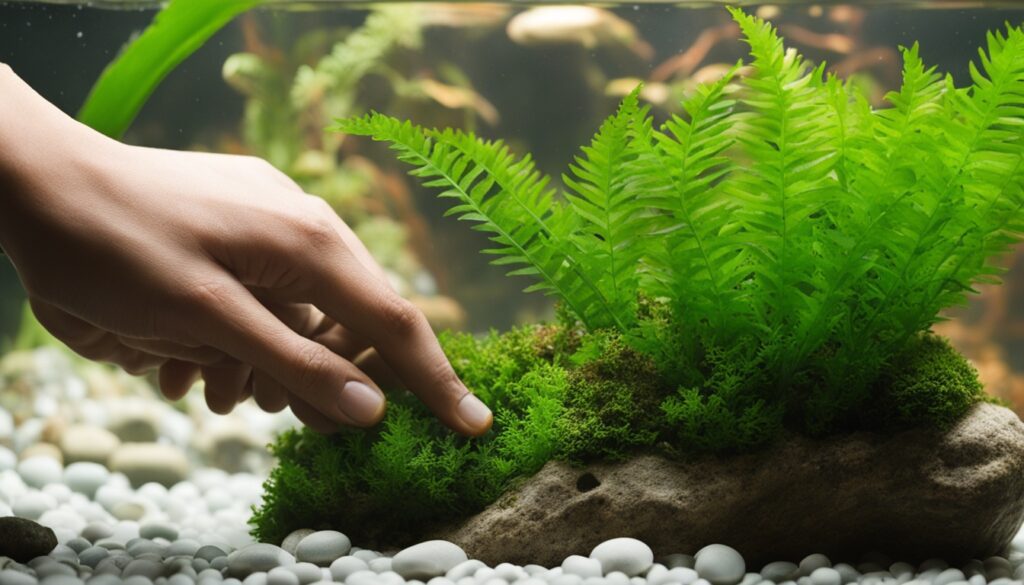
Adding a Java Fern to your aquarium design boosts both looks and balance. It’s known for its tough nature and easy care. Planting java fern gives your aquarium a beautiful green touch that’s practical too. Learn how to add this plant to your underwater world.
Selecting the Perfect Spot: Middle or Background Placement
Java Ferns do best in the middle or back of your aquarium. This spot is key for your aquarium design and the plant’s health. It lets the fern grow well without blocking other tank decorations or creatures.
Using Super Glue Gel for Quick and Secure Attachment
Super glue gel is great for attaching java fern. Make sure to glue the rhizome but not the leaves. The roots will then hold onto wood or rocks, fitting nicely into your tank’s look.
Choosing Companions: Compatible Fish and Invertebrates
Java Fern matches well with various fish and invertebrates. For tank mates compatibility, choose calm fish like Tetras or Guppies. Shrimp and Snails are good too. They all live well with plants, keeping your Java Fern safe and sound.
Companion Type |
Examples |
Compatibility Level |
|---|---|---|
Fish |
Gouramis, Cory Catfish, Loaches |
High |
Invertebrates |
Freshwater Snails, Shrimps |
High |
Plant Placement |
Middle to Background |
Optimal |
Understanding the basics of planting java fern, correct attaching java fern technique, and tank mates compatibility helps build a thriving tank. Java Fern not only makes your aquarium look good. It also offers a healthy place for tank life.
Optimal Conditions for Java Fern Growth

To keep Java ferns healthy, you should know about their light, pH, and temperature needs. These factors are key to providing the best care for these plants.
Lighting: Low to Moderate Intensity with a 5000 – 7000 K Bulb
Java ferns thrive under low to moderate light. Use a bulb that’s between 5000 and 7000K, like the 6700K. It provides about 1.5 watts per gallon. This light level not only suits the ferns but also makes them look great in your tank.
Water Parameters: pH Levels and Temperature Ranges
Java ferns do well in a pH of 6-7.5. They can grow in both acidic and slightly alkaline water. Keep the water between 72-82°F (22-28°C) to meet their temperature needs. These conditions help them grow strong.
Nutrition: When to Use Liquid Fertilizer
Sometimes, Java ferns need an iron-rich liquid fertilizer. This is true if the water lacks enough nutrients. Adding this can speed up growth and make their leaves brighter.
Condition |
Optimal Range |
|---|---|
Lighting Intensity |
Low to Moderate (1.5 watts per gallon) |
Color Spectrum |
5000 – 7000 K |
pH Level |
6.0 – 7.5 |
Temperature |
72 – 82°F (22 – 28°C) |
Java Fern Propagation: A Step-by-Step Guide
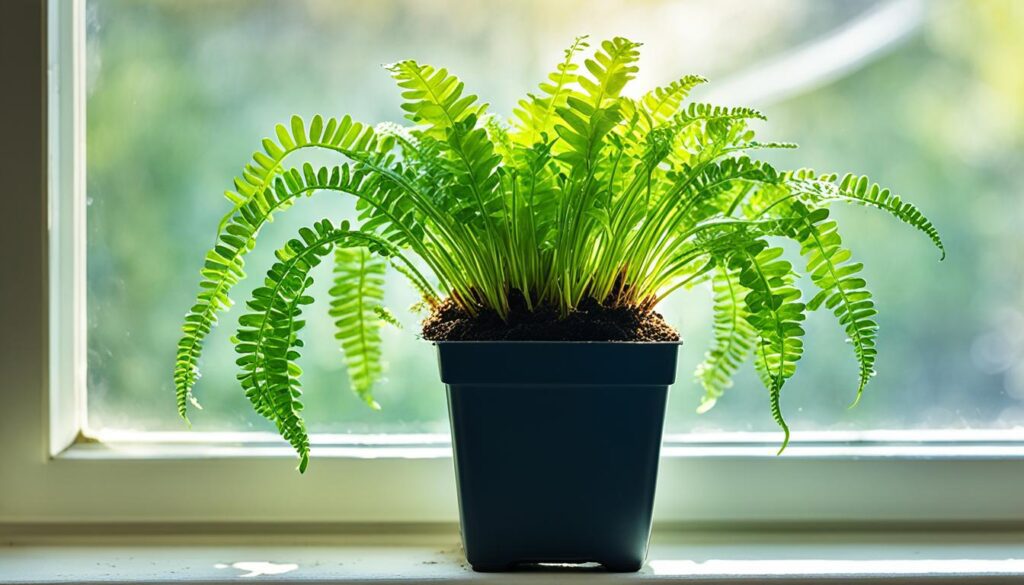
If you love cultivating java fern in your aquarium, learning Java fern reproduction is crucial. It keeps your tank lively and self-sustaining. Let’s look at how to spread this resilient, adaptable plant.
Java fern reproduces aquarium plant propagation by growing plantlets on its leaves. These plantlets help enlarge your underwater garden. They start as tiny buds on the parent’s leaves, growing into full plants, complete with roots.
- Identifying Ready-to-Harvest Plantlets: Find plantlets with 2-3 small leaves and roots showing. This means they’re ready for careful removal from the mother plant.
- Separation: Twist off the plantlet or cut it free with clean scissors. Be gentle to avoid hurting both the baby and the parent plant.
- Attachment: Pick a spot in your tank that meets the Java fern’s needs—like on driftwood or rocks. Tie the plantlet there with fishing line or cotton thread. Give it space to attach and grow.
Rhizome division is another way to spread Java fern. Cut the main rhizome into pieces, each with some leaves and roots. Then, attach them to new spots in your tank.
Here’s a quick guide:
Method |
Description |
Expectations |
|---|---|---|
Plantlet Separation |
Detach and reattach plantlets grown on parent leaves. |
Quickly adds more plants; keeps plants the same genetically. |
Rhizome Division |
Cut and replant parts of the main rhizome. |
Helps with plant placement; leads to strong growth. |
Mastering Java fern reproduction and cultivating java fern beautifies your aquarium and builds a healthier underwater world. Beginners or those seeking detailed steps, click how to propagate Java Fern.
For all aquarists, starting or experienced, mastering these propagation methods is vital. They help your water plants flourish, making your aquarium both stunning and balanced.
Rooted in Versatility
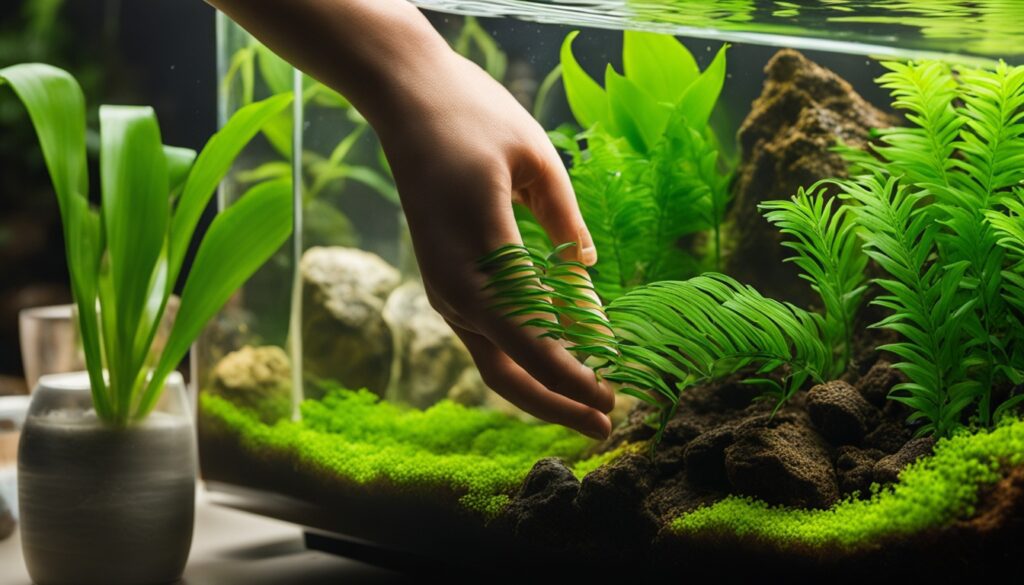
The Java fern is a favorite among aquarium lovers for good reason. It’s both adaptable and flexible, making it popular for water gardens. With simple Java fern planting methods and a strong nature, this plant decorates aquariums well. It also does well in many settings, showing great aquarium plant versatility.
The way you can attach Java ferns offers room for creativity in designing underwater scenes. You can attach them to driftwood, place them among rocks, or let them float. These options cater to different looks and the plant’s health, thanks to varied java fern cultivation methods.
Attachment Freedom: Driftwood, Rocks, and Floating Options
Driftwood is a natural choice for Java ferns, adding a rustic look to tanks. Rocks give a solid base, perfect for creating a varied underwater landscape. Letting Java ferns float adds a magical touch and works well because they need little from their roots.
Plantlets and Rhizome Division
Java ferns reproduce through plantlets and rhizome division, showcasing their ability to thrive. You can separate plantlets from adult leaves to start new plants, which is quite easy. Dividing the rhizome helps manage growth and spreading in the aquarium.
Feature |
Details |
|---|---|
Maximum Growth |
38cm / 15 inches |
Growth Rate |
Slow |
pH Level |
pH 4.0 – 7.5 |
Temperature Range |
18°C – 28°C |
General Hardness |
0 – 30°dGH |
Attachment Preferences |
Driftwood, Rocks, Free-floating |
Propagation Method |
Rhizome division, Plantlets |
Learning about Java ferns’ versatility helps beginners grow them successfully. It also inspires experienced aquarists to try new things in their water gardens.
Signs of Growth and Potential Concerns
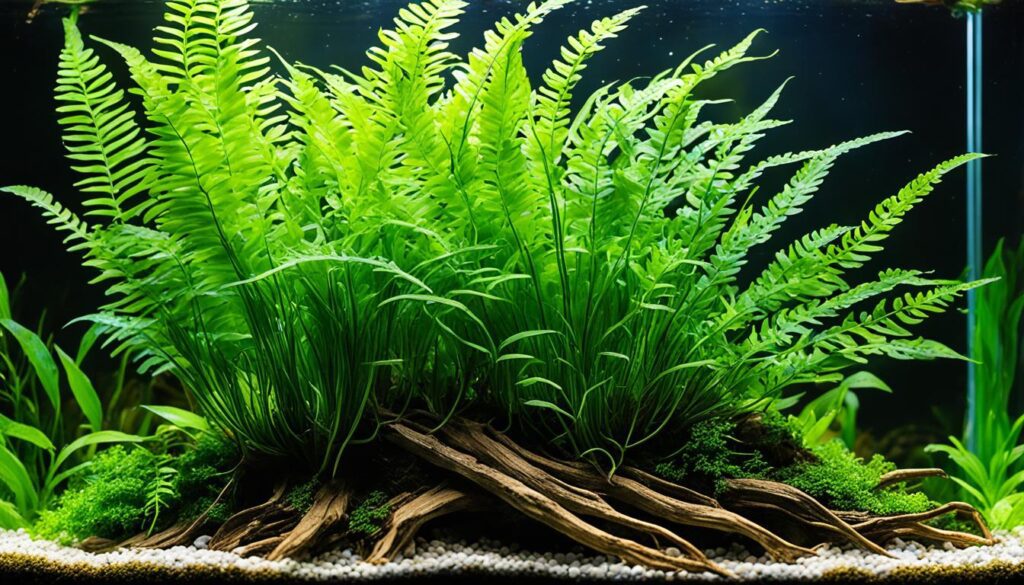
When nurturing Java Fern in your aquarium, Java fern health indicators are key. Many aquarists, myself included, often notice leaves turning brown or having black spots. Spotting these problems early aids in addressing potential Java fern diseases or growth issues.
Based on my experience and talks with others, light plays a huge role in aquarium plant growth. Switching to a Fluval Plant 3.0 LED light often boosts plant health. Similarly, improving water quality by adjusting CO2, pH, and hardness is critical for Java Ferns’ growth.
A mistake I’ve seen, including from myself, is ignoring the need for balanced nutrients, especially potassium. After increasing potassium for my Java Fern, its health and toughness significantly improved. Choose fertilizers wisely. I saw real benefits only when I chose fertilizers that met my plant’s specific needs, despite using Nilocg Thrive regularly before.
Java fern diseases might seem like a big problem, but they can be overcome. By adjusting light, fertilizer, and water quality, you can boost your plant’s growth. Taking the time to tweak these factors can prevent you from having to replace struggling Java Ferns.
Keeping an eye on new leaf growth is a good way to check Java fern health indicators. New leaves show the plant is adjusting well. Remember, it’s normal for growth to slow down when it’s colder.
By following these tips, you improve your aquarium’s look and its balance. This makes sure your Java Fern doesn’t just live, but flourishes.
Combating Java Fern Algae: Prevention and Treatment

Algae can make your aquarium look bad and harm your plants, like java ferns. To keep your water garden healthy and bright, it’s important to stop and treat algae. Let’s look at the best ways to do this.
Water Flow and Tank Maintenance: Keeping Algae at Bay
For java fern care, controlling your tank’s setting is key to stopping algae. Good water flow and regular cleaning help a lot. This stops algae spores from sticking to your java fern and other plants.
Keeping up with cleaning stops algae’s food sources. This keeps your tank clean and your fish happy.
- Clean the tank regularly to remove debris and uneaten food.
- Perform regular water changes, ideally about 10-20% weekly.
- Ensure filters are clean and functional to enhance water flow and filtration.
Post-Algae Care: Rejuvenating Affected Java Ferns
If algae hits your java fern, acting fast can save it. You can gently scrub it off or use a toothbrush. For big issues, treating java fern algae may need chemicals like Seachem Excel. Use them carefully, following the instructions.
- Trim heavily affected leaves to prevent spread.
- Use algae treatment products as required and ensure they are safe for plants.
- Increase water circulation and consider adding a CO2 system to promote plant health.
Adding fast growers like Egeria Densa, Water Wisteria, and Water Sprite helps naturally. They fight algae for food and light, reducing algae’s chances of survival.
Plant Name |
Growth Rate |
Benefits in Algae Control |
|---|---|---|
Egeria Densa |
Fast |
Oxygenates water, uses excess nutrients, shelters fish fry |
Water Wisteria |
Rapid |
Consumes nutrients quickly, reducing algae feed |
Water Sprite |
Rapid |
Competes for light and space, hindering algae growth |
To stop algae effectively, keep your tank in balance. Proper lighting, nutrient checks, and a healthy ecosystem are crucial. By doing this, your aquascape will thrive without algae problems.
Procuring Java Fern: From Local to Online Retailers
Buying java fern really spruces up my aquarium with its green leaves. I found many places to buy it, from local stores to online shops. Online, stores like The Shrimp Farm had lots of types, like Trident and Windelov. The buying process was easy and fast, great for all fish tank lovers.
What stood out was how customer-focused these shops were. Even during tough times like the pandemic, they came through with big orders. Once, a mistake was quickly fixed with a refund, showing their integrity. The Aquascaperoom got a perfect score for their service. They really care, following up and handling orders quickly. This is why everyone who shops there loves it.
If you buy online, they usually ship on Tuesdays if you order by Sunday night. Plants might look a bit different because they grow under different conditions. Fins & Flora explain this well. If something’s not available, they tell you fast and offer substitutes or refunds. Customers like the extra help they get with their plants. Plus, you get organic food for the plants and store credit if they’re damaged on the way. This all shows how much these stores care.
